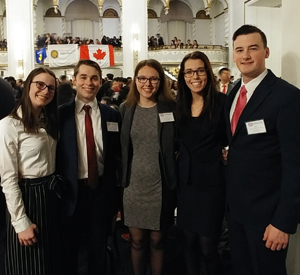
Students in the St. Thomas University Model United Nations class are in Boston this week to participate in the sixty-fourth Harvard Model United Nations.
Representing the country of Iran, Philippe Ferland, Rachelle Patrick, Jarrod Ryan, Rachel Slipp, and Emilie Hanlon will join more than 3,000 delegates from around the world to participate in various committees to work toward resolutions of global issues.
Ferland and Patrick will be part of the Arab League; Jarrod Ryan will work within the Economic and Financial Committee; Slipp’s involvement will be on the Commission on the Status of Women; and Hanlon will represent Iran on the World Health Organization.
Hanlon, a third-year Human Rights and Psychology major, has prepared to be a voice for Iran on the World Health Organization as part of two issues put to the delegates: the effects of climate change on human health and wartime social psychology. She said the class has helped her develop skills in diplomacy.
“It’s hard to represent a country that’s different from your own. You may not agree with the perspective you have to take on these issues, but you have to accurately represent your assigned country’s interest,” she said.
Hanlon said this is an important part of what the Model UN teaches and why she decided to take the class.
"I took the class to challenge myself. I wanted to learn how to debate and handle being put on the spot. I eventually want to work in law or social work, so this has been a great opportunity for me to develop skills that will be essential in those two fields.”
Faculty Advisor for the Model UN class at St. Thomas, Stephanie McAnany, said the students have spent a great deal of time diving into their topics and learning about Iran’s foreign policy in preparation for the event in Boston.
“Within their committees, they will have to navigate how to work diplomatically with countries who hold opposing views to their own while pushing their own agenda in an effort to adopt a resolution by the end of the simulation. This is no easy task,” McAnany said.
“The students are challenged by having to think quickly on their feet, speak in front of a large number of delegates, many of which are coming from ivy league schools in the United States, and become leaders within their own committees,” she added.
Founded in 1955, the Harvard National Model United Nations is the largest, oldest, and most prestigious conference of its kind. STU has sent a team to the competition for over two decades.
/filters:format(webp)/prod01/stuca/media/stu/site-assets/images/features/Internship-Lauren-Feature.jpg)
/filters:format(webp)/prod01/stuca/media/stu/site-content/news/BEd.jpg)
/filters:format(webp)/prod01/stuca/media/stu/site-assets/images/features/Bank-of-Canada-Governors-Challenge.jpg)